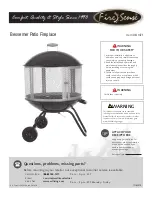
10
LP-374 REV. 3.25.14
F. CONDENSATION DRAIN TUBES
This unit has a built-in condensation tray to collect moisture discharge from the
evaporator coil. The water collected in the tray drains out of the tube on the back of
the unit. Two flexible hoses are included with this unit. It is important that both of
these hoses are attached to the two drain ports on the back of the unit.
Attach the shorter 3” hose to the top drain port.
Cut a 1 ½” piece off the long hose. Connect this piece to one end of the elbow
barbed fitting (included). Attach longer piece of the hose to the other end of the
barbed fitting.
Next, connect the short section with attached barbed fitting to the lower drain port
on the back of the unit, below the rear cover. . Direct the longer end to a drain in the
floor or no higher than 3’ above the floor. If such a drain is unavailable, a
condensate drain pump (not provided) must be purchased and installed.
NOTE:
If condensate hose is kinked during shipping, DO NOT INSTALL ON THE
UNIT. A kinked hose should not be used, as condensate flow may be compromised
and overflow could occur. Replace kinked hose with hose of the same size,
available at most hardware or plumbing supply stores.
Failure to properly drain condensate could lead to water leakage and property damage. Such damage IS NOT covered by warranty.
Do not attach the same hose to both condensate ports. Doing so will lead to improper operation, condensate leakage, and property
damage. Such damage IS NOT covered by warranty.
G. RELIEF VALVE
A new combination temperature and pressure relief valve, complying with the Standard for Relief Valves and Automatic Gas Shut-Off
Devices for Hot Water Supply Systems, ANSI Z21.22, is supplied and must remain installed in the opening provided and marked for the
purpose on the water heater. No valve of any type should be installed between the relief valve and the tank. Local codes shall govern
the installation of relief valves.
The pressure rating of the relief valve must not exceed 150 PSI, the maximum working pressure of the water heater as marked on the
rating plate. Failure to follow this warning could result in explosion, property damage, personal injury, or death.
The BTUH rating of the relief valve must not be less than the input rating of the water heater as indicated on the rating label located on
the front of the water heater (1 watt = 3.412 BTUH).
Connect the outlet of the relief valve to a suitable open drain so that the discharge water cannot contact live electrical parts or persons
and to eliminate potential water damage.
Piping should be of a type approved for hot water distribution. The discharge line must be no smaller than the outlet of the valve and
must pitch downward from the valve to allow complete drainage (by gravity) of the relief valve and discharge line. The end of the
discharge line should not be threaded or concealed and should be protected from freezing. No valve of any type, restriction or reducer
coupling should be installed in the discharge line.
The condensate line must remain unobstructed. If condensate is allowed to freeze in the line or obstructed in any other manner,
condensate can exit from the water appliance tee, resulting in potential water damage to property.
When installing a condensate pump, select one approved for use with condensing appliances. The condensate pump should have an
overflow switch to prevent property damage from spillage.
Figure 8
– Condensate Detail











































